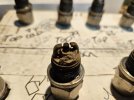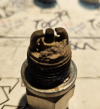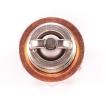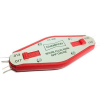Lndwarrior
Cleared for Takeoff
- Joined
- Jan 15, 2009
- Messages
- 1,124
- Display Name
Display name:
Gary
From my O-235-C1 engine. #2, bottom plug.
These were cleaned 11 months ago and about 50 hours.
The engine had been unusually hard to start the last two times so I decided to pull the plugs a month before the condition inspection.
For 10 of the last months I was running 100LL. The last month or so I started running mogas to help avoid this problem.
A few other plugs had some buildup but not as bad as this one.
Wondering if anyone has any thoughts on this excessive buildup? I've not seen anything this bad in the last 5 condition inspections.
I lean on the ground and in the air, every time. Also do a runup at engine shut down to help clear the plugs.

These were cleaned 11 months ago and about 50 hours.
The engine had been unusually hard to start the last two times so I decided to pull the plugs a month before the condition inspection.
For 10 of the last months I was running 100LL. The last month or so I started running mogas to help avoid this problem.
A few other plugs had some buildup but not as bad as this one.
Wondering if anyone has any thoughts on this excessive buildup? I've not seen anything this bad in the last 5 condition inspections.
I lean on the ground and in the air, every time. Also do a runup at engine shut down to help clear the plugs.




